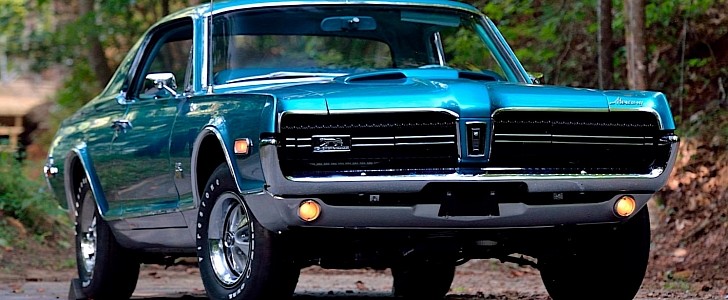The shiny, Madras Blue Mercury Cougar GT-E you see here was not always like this. It was uncovered in 2019 in a heated barn in Wisconsin, wrapped in a very thick layer of dust, but otherwise rather well preserved. It was in need of some work though, so a rotisserie restoration was commissioned. Last weekend, the 1968 Mercury Cougar GT-E snatched $132,000 at auction.
Today, the Mercury brand is no longer among us. It fell victim to the great purge of the early 2010s, as Ford’s biggest sacrifice to the altar of the economic crisis. While it was alive, Mercury’s major, best selling nameplate was the Cougar. Introduced in 1967 and on the market until 2002, the Cougar was a lot of things: it was seen as either a luxury car or a pony, by some as a sports car, or a combination of them all.
In the Cougar family, the GT-E occupies a special place. Introduced in 1968 alongside the GT, it packed a racing-derived powerplant, a different design from the rest of the range and, above all, rarity – records show just close to 400 of them were ever made.
That means finding a Cougar GT-E in this condition is not an easy thing. Finding one that comes with almost all the original parts, including the powerplant (427ci/7.0-liters) and down to the glass, is nearly impossible. Nearly because, well, here’s one.
The car was part of the Mecum Indy Special auction last week. It went for $132,000, coming in fifth on the list of most valuable vehicles sold there, partly because of what it represents in the history of American cars, and partly because of the way in which was preserved and restored.
The seller said “there are fewer than a dozen of these Cougars still in existence with their original drivetrain, and less than half of those are in running order.” What’s more, we’re informed that of those in running order “none are restored to this level of detail,” but there’s literally no way to verify that claim.
In the Cougar family, the GT-E occupies a special place. Introduced in 1968 alongside the GT, it packed a racing-derived powerplant, a different design from the rest of the range and, above all, rarity – records show just close to 400 of them were ever made.
That means finding a Cougar GT-E in this condition is not an easy thing. Finding one that comes with almost all the original parts, including the powerplant (427ci/7.0-liters) and down to the glass, is nearly impossible. Nearly because, well, here’s one.
The car was part of the Mecum Indy Special auction last week. It went for $132,000, coming in fifth on the list of most valuable vehicles sold there, partly because of what it represents in the history of American cars, and partly because of the way in which was preserved and restored.
The seller said “there are fewer than a dozen of these Cougars still in existence with their original drivetrain, and less than half of those are in running order.” What’s more, we’re informed that of those in running order “none are restored to this level of detail,” but there’s literally no way to verify that claim.




















